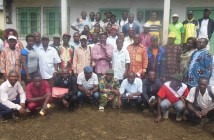To measure the state of environmental education in Takamanda, in Southwest Cameroon, Environmental Governance Institute (EGI) carried out a assessment in nine villages that make up the south west cluster of the Takamanda National Park. Semi-structured questionnaires were administered to students from 11 schools. In total, 212 randomly selected students of classes 5 and 6 from 8 primary schools and Form 1 to 6 in secondary schools, as well as 16 teachers participated.
Here is a summary of the findings:
- Students generally have a good understanding about the importance of sustainable practices. Most agree that resources should be used sustainably and that conserving nature is of advantage to sustainable development. They believe that environmental education is about nature and ecosystems and that it should stress on the reuse and recycling of resources.
- Secondary school students have a good theoretical understanding of issues such as the impact of poor agricultural practices and population increase, the meaning of sustainable use of natural resources, wildlife found in their area and endangered species. However, although they are situated in a biodiversity rich area, they seem to have little or no opportunity to practically get involved in resolving these issues.
- Over 90% of the students state that environmental education is taught as a separate subject in their syllabus. More than half acknowledge that they have school gardens. However, most of them indicated that they do not have groups that could help them to get directly involved in sustainability initiatives and almost none have ever undertaken a field trip related to nature and environmental awareness.
- All the respondent teachers commonly integrate some aspects of sustainability as a unit within a subject, especially science, agriculture and general knowledge. A few of them have integrated activities into health and fitness, social sciences and language classes. Teachers agree that audio-visual aids are useful as instructional material on sustainable practices, but they have little or no access to such materials. Less than one third of them use out-of-classroom activities.
- One third of the teachers promote environmental sustainability in their school either by sensitizing students on natural resource management, and carrying out activities like afforestation. A smaller number carry out sensitization on sanitation and conservation.
- At school level, whereas teachers have made efforts to integrate ESD into theoretical lessons, there clearly lacks opportunities for students to undertake participatory out-of-class activities. Teachers in the schools need not only capacity building on pedagogical approaches that can promote active ESD implementation, but also the resources that will enable them implement these approaches.
EGI has initiated some activities to strengthen the capacity of teachers in schools around Takamanda to implement ESD approaches.



